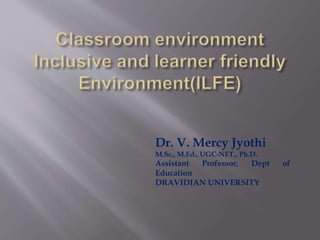
Class room environment. (learner friendly and inclusive environment).pptx
- 1. Dr. V. Mercy Jyothi M.Sc., M.Ed., UGC-NET., Ph.D. Assistant Professor, Dept of Education DRAVIDIAN UNIVERSITY
- 2. Inclusion is about practical changes we can make so that all children, including those with diverse backgrounds and abilities, can succeed with their education and enjoy learning. These changes will not merely benefit the children we often single out as children with special educational needs, but all children and their parents, all teachers and school administrators, and everyone from the community who works with the school.
- 3. “Inclusive” does include children with disabilities such as children who have difficulties in seeing or hearing, who cannot walk, or who are slower to learn. HOWEVER, “inclusive” also means including ALL children who are left out or excluded from school. “Inclusive” means that as teachers, we have the responsibility to seek out all available support (from school authorities, the community, families, children, educational institutions, health services, community leaders, and so on) to finding children who are out of school and facilitating ALL children to learn.
- 4. 1. Children affected by conflict. 2. Children affected by drugs 3. Children from ethnic, language, social and religious minorities 4. Children from poor economic backgrounds 5. Children living far away from school - in villages where there are no schools 6. Children suffering from neglect, abandonment and abuse 7. Children who are over-aged 8. Children with disabilities and disabling health conditions 9. Girls 10. Street and Working Children
- 5. For instance, they may be children; • who get lessons and have to read textbook in a language that is not their first language (mother tongue); • who are never asked to contribute; • who never offer to contribute; • who can’t see the blackboard or a textbook or can’t hear the teacher; • who can’t hear well; • who have difficulties with speech (speech impairment or “stuttering”), or; • children who are not learning well and no attempts are being made to help them. These children may be sitting at the back of the classroom and may soon leave altogether (drop out). As teachers, we are responsible for creating a learning environment where ALL children can learn, ALL children want to learn, and ALL children feel welcome and included in our classrooms and schools.
- 6. Many schools are working to become “child-friendly,” where children have the right to learn to their fullest potential within a safe and welcoming environment. The aim is to improve each child’s participation and learning in school, rather than concentrating on the subject matter and examinations. A “learning-friendly” environment is “child-friendly” and “teacher-friendly.” It stresses the importance of students and teachers working together as a learning community. It places children at the centre of learning and encourages their active participation in learning. It also fulfils our needs and interests as teachers. It enables us and encourages us to give all children the best education possible.
- 7. They are all based on the same six principles or dimensions: 1. Rights-based, inclusive and child seeking 2. Effective – Focusing on the intellectual, social, emotional and physical development of all children 3. Healthy, safe and protective 4. Gender responsive 5. Community based and family focused 6. Child-friendly systems and policies – Child-friendly assessment and evaluation systems, curricula and support systems. It is important to understand that no school can be child-friendly unless it is inclusive, no school can be inclusive unless it is child-friendly, and that no school can offer quality education unless it is inclusive and child-friendly.
- 8. Which classroom below do you think is inclusive and learning- friendly?
- 9. Traditional classroom Inclusive, learning-friendly classroom Relationships between the teacher, classroom helper and the children Who is in the classroom? Seating arrangement Learning materials Resources Evaluation
- 10. Think about the elements of an inclusive, learning-friendly classroom mentioned in the table above, and ask yourself the following questions? • What type of classroom do I work in? • What changes can I introduce to make my classroom to make it more inclusive and learning friendly? • How can I make the topics I teach more interesting for my children so they will want to learn about them? • How can I arrange my classroom so that ALL of the children are learning together? • Who can help me to create an ILFE (for example, the Principal, other teachers, my students, parents, and community leaders)? • Who can help me in the class, what other teaching-learning resources are available in the community (adults and children)
- 11. Benefits for Children Through an ILFE children will among others learn how to; become more self-confident; • develop greater self-esteem; • take pride in themselves and their achievements; • learn independently both inside and outside of school; • ask good questions; • be good observers; • be more creative; • improve their communication and interpersonal skills;
- 12. They will: • have more opportunities to learn new ways to teach different kinds of students; • learn how to explore new ideas by communicating more often with teacher colleagues from within and outside their school through school clusters or teacher networks; • receive valuable input and assistance from parents and community members; • gain new knowledge, such as the different ways children learn and can be taught; • learn how to find solutions and overcome challenges, instead of just seeing problems and obstacles; • develop more positive attitudes and approaches towards children (and their families) as well as challenging situations; • get more positive feedback from their students by applying these new ideas; • experience a higher sense of accomplishment when ALL their students are succeeding in school to the best of their abilities;
